Description
The codex contains Lessons from the Gospels lectionary (Evangelistarium), Acts, Paul and Catholic epistles (Apostolarium). [1] It contains also some additional matter with names of monks and woman. [2]

A lectionary is a book or listing that contains a collection of scripture readings appointed for Christian or Judaic worship on a given day or occasion. There are sub-types such as a "gospel lectionary" or evangeliary, and an epistolary with the readings from the New Testament Epistles.

Acts of the Apostles, often referred to simply as Acts, or formally the Book of Acts, is the fifth book of the New Testament; it tells of the founding of the Christian church and the spread of its message to the Roman Empire.

The Pauline epistles, Epistles of Paul, or Letters of Paul, are the thirteen books of the New Testament, composed of letters which are largely attributed to Paul the Apostle, although authorship of some is in dispute. Among these letters are some of the earliest extant Christian documents. They provide an insight into the beliefs and controversies of early Christianity. As part of the canon of the New Testament, they are foundational texts for both Christian theology and ethics. The Epistle to the Hebrews, although it does not bear his name, was traditionally considered Pauline for a thousand years, but from the 16th century onwards opinion steadily moved against Pauline authorship and few scholars now ascribe it to Paul, mostly because it does not read like any of his other epistles in style and content. Most scholars agree that Paul really wrote seven of the Pauline epistles, but that four of the epistles in Paul's name are pseudepigraphic ; scholars are divided on the authenticity of two of the epistles.
The lessons of lectionary following the Byzantine Church order (15 lessons are from New Testament, three lessons are from Book of Isaiah). [1] It is written in Greek minuscule letters, on 316 paper leaves (15.2 cm by 10.1 cm), 2 columns per page, 22 lines per page. [3] [4]

The Book of Isaiah is the first of the Latter Prophets in the Hebrew Bible and the first of the Major Prophets in the Christian Old Testament. It is identified by a superscription as the words of the 8th-century BCE prophet Isaiah ben Amoz, but there is extensive evidence that much of it was composed during the Babylonian captivity and later. Bernhard Duhm originated the view, held as a consensus through most of the 20th century, that the book comprises three separate collections of oracles: Proto-Isaiah, containing the words of Isaiah; Deutero-Isaiah, the work of an anonymous 6th-century BCE author writing during the Exile; and Trito-Isaiah, composed after the return from Exile. While virtually no scholars today attribute the entire book, or even most of it, to one person, the book's essential unity has become a focus in more recent research. Isaiah 1–33 promises judgment and restoration for Judah, Jerusalem and the nations, and chapters 34–66 presume that judgment has been pronounced and restoration follows soon. It can thus be read as an extended meditation on the destiny of Jerusalem into and after the Exile.
It uses breathing and accents. [5]
History
Scrivener dated the manuscript to the 14th or 15th century. [6] Gregory dated it to the 14th century. [1] It has been assigned by the Institute for New Testament Textual Research (INTF) to the 16th century. [3] [4]
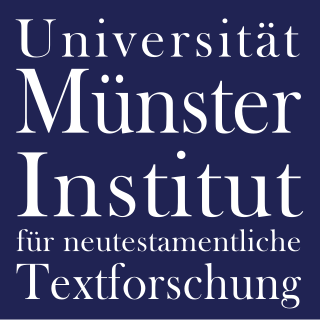
The Institute for New Testament Textual Research at the University of Münster, Westphalia, Germany, is to research the textual history of the New Testament and to reconstruct its Greek initial text on the basis of the entire manuscript tradition, the early translations and patristic citations; furthermore the preparation of an Editio Critica Maior based on the entire tradition of the New Testament in Greek manuscripts, early versions and New Testament quotations in ancient Christian literature. Under Kurt Aland's supervision, the INTF collected almost the entire material that was needed - Manuscript count 1950: 4250; 1983: 5460; 2017: approx. 5800.
Of the history of the codex ℓ315 nothing is known until 1864, when it was in the possession of a dealer at Janina in Epeiros. It was then purchased from him by a representative of Baroness Burdett-Coutts (1814–1906), a philanthropist, [7] together with other Greek manuscripts (among them lectionaries ℓ313 and ℓ314) [1] and they were all transported to England in 1870–1871. The manuscript was lost at the beginning of the 20th century. [8]

Ioannina, often called Yannena within Greece, is the capital and largest city of the Ioannina regional unit and of Epirus, an administrative region in north-western Greece. Its population is 112,486, according to 2011 census. It lies at an elevation of approximately 500 metres above sea level, on the western shore of lake Pamvotis (Παμβώτις). Ioannina is located 410 km (255 mi) northwest of Athens, 260 kilometres southwest of Thessaloniki and 80 km east of the port of Igoumenitsa in the Ionian Sea.

Angela Georgina Burdett-Coutts, 1st Baroness Burdett-Coutts, born Angela Georgina Burdett, was a nineteenth-century philanthropist, the daughter of Sir Francis Burdett, 5th Baronet and Sophia, formerly Coutts, daughter of banker Thomas Coutts. In 1837 she became one of the wealthiest women in England when she inherited her grandfather's fortune of around £1.8 million following the death of her stepgrandmother, Harriot Mellon. She joined the surnames of her father and grandfather, by royal licence, to become Burdett-Coutts. Edward VII is reported to have described her as, "[a]fter my mother, the most remarkable woman in the kingdom."

Lectionary 313 (Gregory-Aland), designated by siglum ℓ313 is a Greek manuscript of the New Testament, on parchment. Palaeographically it has been assigned to the 14th-century. The manuscript has survived in a fragmentary condition.
The manuscript was added to the list of New Testament manuscripts by F. H. A. Scrivener (253e 67a) and Caspar René Gregory (number 313e 184a). [1] Scrivener collated its text. [9]

Caspar René Gregory was an American-born German theologian.
It was held in London (Burdett-Coutts III. 42). [1] The current location and owner of the codex are unknown. [3] [4]
The manuscript is not cited in critical editions of the Greek New Testament (UBS4, [10] NA28 [11] ).
Minuscule 66, ε 519, known as Codex Galei Londinensis, is a Greek minuscule manuscript of the New Testament, on paper leaves. Palaeographically it has been assigned to the 14th century.
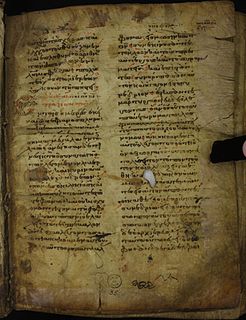
Lectionary 170, designated by siglum ℓ 170 is a Greek manuscript of the New Testament, on parchment leaves. Palaeographically it has been assigned to the 14th century.
Scrivener dated it to the 12th or 13th century. Formerly it was labelled as Lectionary 68a. Scrivener by 65a.
Minuscule 538, ε 335, is a Greek minuscule manuscript of the New Testament on a parchment. Dated palaeographically to the 12th or 13th century. Formerly it was labelled as Wd and 552 (Scrivener).
The manuscript is lacunose.
It was adapted for liturgical use.
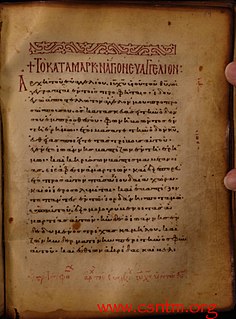
Minuscule 532, ε 255, is a Greek minuscule manuscript of the New Testament, on parchment. Palaeographically it has been assigned to the 12th century.
Scrivener labeled it number 545.
The manuscript was adapted for liturgical use. It is very incomplete, with many omissions and faded text along with much of it being missing because a missing manuscript contains some of the text.
Minuscule 534, 547, ε 333, is a Greek minuscule manuscript of the New Testament, on a paper. Palaeographically it has been assigned to the 13th century. The manuscript was adapted for liturgical use. It is lacunose.

Minuscule 535, 548 (Scrivener), ε 140, is a Greek minuscule manuscript of the New Testament, on a parchment, dated to the 12th century. It was adapted for liturgical use, with full marginalia.
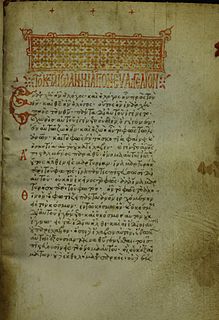
Minuscule 536, δ 264, is a Greek minuscule manuscript of the New Testament, on parchment. Palaeographically it has been assigned to the 13th century.
Scrivener labeled it by number 549.
Several pages of the manuscript were lost. Incomplete marginalia. The manuscript is available in a digital form on the internet.

Minuscule 537, ε 334, is a Greek minuscule manuscript of the New Testament, on a parchment. Palaeographically it has been assigned to the 12th century. Scrivener labelled it by number 550. The manuscript was prepared for liturgical use, its marginalia are not complete. It has survived until the present day in complete condition.
Minuscule 540, ε 334, is a Greek minuscule manuscript of the New Testament, on a parchment. Palaeographically it has been assigned to the 14th century.
Scrivener labelled it by number 553.
It has marginalia. The manuscript has no complex context.

Minuscule 541, 554, ε 400, is a Greek minuscule manuscript of the New Testament, on a parchment. Palaeographically it has been assigned to the 15th century.
Minuscule 542, ε 336, is a Greek minuscule manuscript of the New Testament, on a parchment. Palaeographically it has been assigned to the 13th century.
Scrivener labelled it by number 555.
The manuscript is lacunose. Currently it is inaccessible.

Minuscule 544, 557, ε 337, is a Greek minuscule manuscript of the New Testament, on parchment. The manuscript has complex contents. Palaeographically it has been assigned to the 13th century.
It was not adapted for liturgical use.
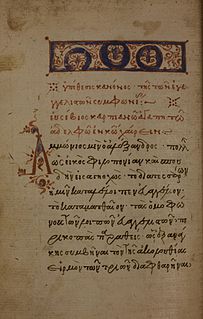
Minuscule 545, ε 511, is a Greek minuscule manuscript of the New Testament, on paper. It is dated by a colophon to the year 1430.
Scrivener labeled it by number 558. It is housed at the University of Michigan. It has marginalia.

Minuscule 546, ε 511, is a Greek minuscule manuscript of the New Testament, on parchment. It is dated palaeographically to the 13th century. It has some marginalia, the scribe has made numerous errors.
Lectionary 186, designated by siglum ℓ 186 is a Greek manuscript of the New Testament, on parchment leaves. Palaeographically it has been assigned to the 11th century.
Scrivener labelled it by 221e.
Minuscule 672, ε 156, is a Greek minuscule manuscript of the New Testament, on parchment. Palaeographically it has been assigned to the 11th century. The manuscript is a very lacunose. Scrivener labelled it by 618e.

Lectionary 216, designated by siglum ℓ 216 is a Greek manuscript of the New Testament, on parchment. Palaeographically it has been assigned to the 13th century.
Scrivener labelled it by 251evl and 64apost.

Lectionary 223, designated by siglum ℓ 223 is a Greek manuscript of the New Testament, on paper. Palaeographically it has been assigned to the 15th century.
Frederick Henry Ambrose Scrivener labelled it by 252evl.
It contains much additional material, liturgical and secular.

Lectionary 228, designated by siglum ℓ 228 is a Greek manuscript of the New Testament, on paper. Palaeographically it has been assigned to the 15th century.
Frederick Henry Ambrose Scrivener labelled it by 253evl.
Some leaves of the manuscript were lost.

Minuscule 699, δ104, is a Greek minuscule manuscript of the New Testament, on parchment. Palaeographically it has been assigned to the 11th century. Some leaves of the manuscript were lost. Scrivener labelled it by 603e.























